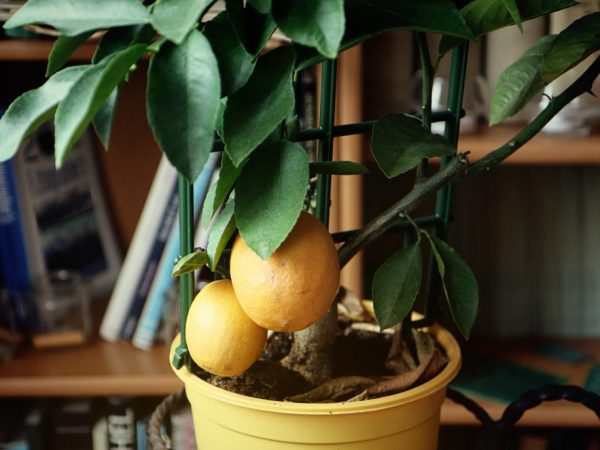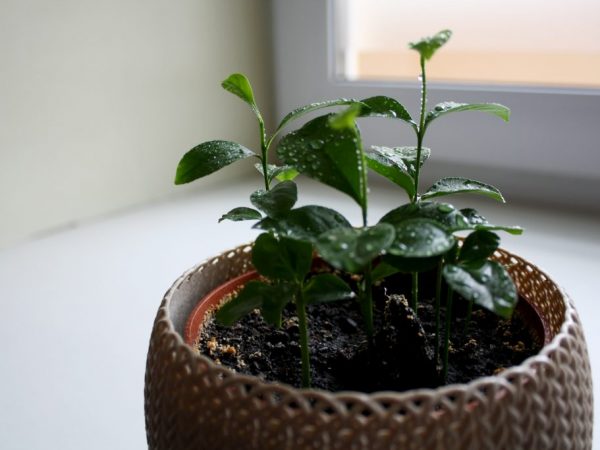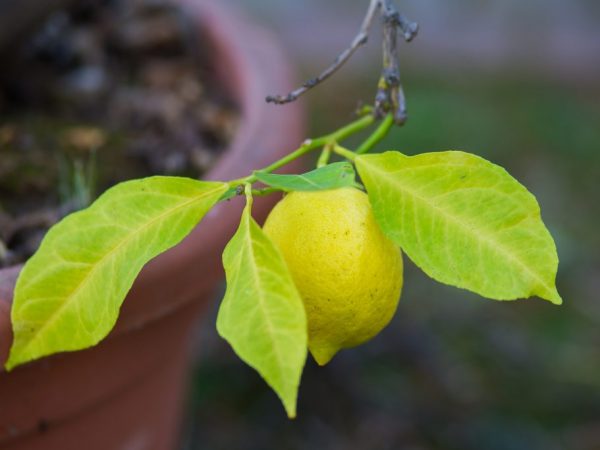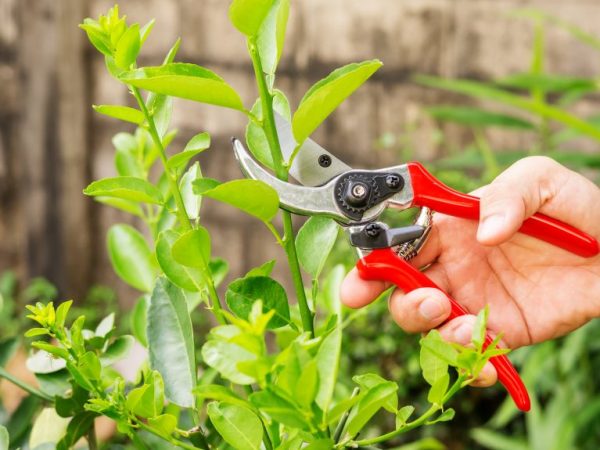Growing a lemon tree at home
Lemon is a citrus plant that is cultivated for pilaf. They are used in cooking and medicine, due to the presence of many useful substances in the composition. The lemon tree is also grown at home for decorative purposes. The plant is unpretentious and bears fruit regularly.

Growing a lemon tree at home
Description of indoor lemon
The lemon tree is a hybrid type of houseplant. Low-growing evergreen trees are grown at home. Their branches are covered with a small number of thorns. Young shoots have a bright purple hue. Citrus has a long lifespan.
The leaves are described as light green, oval in shape with a pointed edge. They are dense, with a lot of glands, and also contain essential oils inside. There are jagged edges at the edges of the leaves. Foliage lives 1.5-3 years. Lemon flowers are large and have a bright pleasant aroma. They bloom for several weeks.
Fruits ripen 8-10 months from the beginning of the ovary. Lemons have different shapes depending on the variety, but always resemble an oval with pointed edges. The fruits are covered with a dense yellowish-orange skin. The surface is pitted and lumpy, the zest has a bright aroma.
The flesh of the fruit is bright yellow. Juicy with a sweet and sour taste. The pulp is divided into parts. Inside are also white ovoid seeds covered with a thin layer of shell.
Varieties
The following varieties of indoor lemon are grown at home:
- Pavlovsky. Selection variety. The lemon tree is tall, reaching 2 m in height. The crown is dense, but small. Its diameter does not exceed 1 m. The tree produces 25-45 fruits per year with a bright sour taste and a small number of seeds inside. The skin is rough, its thickness is 3-5 mm. Fruits are medium in size. The length of one lemon reaches 10-12 cm, and its weight does not exceed 160 g.
- Lunario. A variety with a high yield. It is also used for decorative purposes. The home lemon tree grows up to 1.5 m in height. There are thorns on the branches. The fruits are in the shape of an oblong oval. The pulp is juicy, but has a bright taste. Lemon is able to bloom and bear fruit at the same time.
- Ponderosa. The lemon tree is distinguished by its unpretentiousness to growing conditions, it is resistant to drought. Plant height reaches 1.7 m. The tree has a dense lush crown. The fruits have a juicy, sweetish pulp. The variety quickly begins to bear fruit.
- Meyer. A small dwarf plant that grows to 1.2 m in height. The lemon tree has a spherical crown with few thorns. Fruit weight - 150-200 g. The peel is thin, has an orange tint. The shade of the lemon tree flowers is red. There are marks on the branches.
Landing
Planting a lemon tree at home in a pot is made from seeds. Planting material is taken from purchased fruits. To plant seeds, lemons are chosen large. For successful cultivation, a special soil is selected.
To plant a lemon tree, use:
- purchased soil for citrus fruits;
- flower mix;
- soil with peat;
- leafy soil;
- soil with sand and organic fertilizers.
Lemons prefer light, slightly acidic soils with good water permeability. Growing begins in a small pot or cup. Also for indoor lemon drainage is needed.

Lemon needs good lighting
Landing sequence
- Place a drain on the bottom of the pot. Its volume should not exceed 20% of the total size of the pot.
- Pour a layer of substrate on top. It is loosened until fluffy. The layer of soil should not be higher than the neck of the pot.
- Plant the seeds. They are placed to a depth of 1.5-2 cm. The seeds are planted immediately after being removed from the fruit.
- Place the pot in a bright room. A suitable temperature for seeds is 19 ° C-21 ° C.
Better to plant 10-15 seeds at a time. This will allow you to select the strongest shoots for transplanting. Pot shards, nutshells or small stones are suitable for drainage. Also, before planting, the seeds are treated with biostimulants.
Seedling care
For indoor lemons, maintaining a constant temperature is important. For better germination, the sprout of the lemon tree is covered with cling film or half a plastic bottle. The first shoots appear in 2-4 weeks. The seedlings are kept under cover until 3 leaves appear. 1-2 shoots grow from one seed.
The plant is rearranged in its usual place. In containers, the soil is regularly loosened so that there is access to moisture and oxygen.
Transfer
The strongest sprouts are transplanted into pots with a diameter of up to 10 cm. For transplanting a lemon tree, containers are taken from burnt clay, plastic or non-rotting wood varieties. The pot should have a drainage hole.
Criteria for choosing seedlings to transplant:
- the minimum distance between the kidneys;
- low number of needles;
- quality leaves that do not fall away from the touch;
- strong shoots of maximum thickness.
When transplanting, the pots are also covered with a layer of drainage and substrate. The plants are covered with a glass jar on top to maintain a constant temperature and humidity. It is removed once a day for 20-40 minutes so that the plant is saturated with oxygen.
Under these conditions, the lemon tree develops until it reaches a height of 18 cm. When the first strong leaves appear, the plant is transplanted into a new larger pot. Each new container should be 4-6 cm larger than the previous one. This prevents stagnation of moisture in the soil. When transplanting, it is important not to bury the root collar in the soil: this causes rotting.
Plant care rules
Lemon tree maintenance includes lighting control. For a lemon, a suitable place is a window sill, the window of which faces east or south. The lemon tree will receive 2-3 hours of sunlight per day.
Indoor lemon does not like frequent changes in the growing location. The plant becomes stressed, which causes stunted growth and loss of foliage and fruit. The lemon tree, like the orange one, also does not like turns, but it is better to turn the plant to the sun by 2-3 cm every 2 weeks.
In winter, the lemon feels a lack of light. To take care of it, they buy special ultraviolet lamps.
Temperature

Place the plant away from the battery
The comfortable temperature for an adult indoor lemon is 17 ° C-18 ° C. During the budding period, the lemon tree prefers a lower temperature, but not less than 14 ° C. During the development of fruits, the plant requires 20 ° C-22 ° C.
In warmer seasons, the lemon tree is taken outside into the garden or placed on the balcony. At night, the bushes are wrapped in order to avoid the influence of temperature differences. In winter, lemons feel fine at 12 ° C-14 ° C. To grow a plant disease-free, it must be positioned away from heating appliances to prevent drying out. Also, frostbite should not be allowed.
Watering and spraying
To grow a lemon tree, moisture is required.The plant requires daily watering from mid-spring to early fall. In the rest of the year, moisture is applied 2-3 times a week. It is forbidden to water the soil if it is still wet. This will cause waterlogging, which will lead to the development of fungal diseases. It is better to water the lemon tree with filtered water at room temperature, which has been defended for a day.
You also need to take care of the bush by introducing moisture into the air with a spray. Lemons are sprinkled daily with warm filtered water. In winter, the amount of moisture is increased if there are many heating devices in the house. In cool air, lemons are sprayed 3-4 times a week.
Fertilizers
Indoor lemons are fed with organic and mineral substances. To maximize development, both types of dressings are combined.
For fertilization use:
- nitrogen;
- phosphorus;
- potassium;
- iron;
- calcium
- humus;
- compost;
- peat;
- ash.
Young trees are fed every 2 months. Adults fertilize once every 2 weeks in the spring and summer. In winter, feeding is minimized. At low temperatures, the plant absorbs substances poorly, and all fertilizers remain in the soil.
It is forbidden to feed the plant in dry soil. This leads to a root system burn, from which the indoor lemon dies. Before applying top dressing, the soil is moistened for 1.5-2 hours. If the bush has ceased to bear fruit, phosphorus is not added.
Pruning
When caring for indoor lemon, the formation of the crown is an important part. Its shape depends on the purpose of growing.
Types of crown formation:
- Growing lemon for decorative purposes. The crown is small, dense and neat. Leave the branches with the largest number of blooms.
- Growing for fruit. Only fruiting branches with a large number of shoots are left.
To form a crown of lemons, the pinching method is used. The shoot should be pinched when it reaches a length of 22-26 cm. The next pinching is carried out 16 cm from the previous one. There must be at least 5 developed buds on the segment, which form new shoots.

Pruning shoots will improve fruiting
In the future, they grow in different directions. They are pinched after 25 cm. After ripening, they are cut off 3-6 cm below the pinching point. Each shoot is 5 cm shorter than the previous one. The last step is to trim the shoots of the 4th order in order to make them bear fruit better.
Also, pruning is preventive. It is required to break off and cut off weak and dried branches, shoots growing inside the crown, as well as segments affected by the virus. This will revive old branches and restore yields.
Reproduction
Indoor lemons are propagated by grafting and grafting. For cuttings, shoots are chosen with a thickness of 4-5 mm and a length of at least 12 cm. The lower cut is made under the bud, and the upper one - above it. Each cutting should have 2-4 leaves and 3-5 buds.
The segments are treated with root growth biostimulants and dipped into warm water with a lower cut. After 2-3 days, they are planted in glasses to a depth of 3 cm. For cultivation, a flower mixture with organic fertilizers and river sand is used.
Cuttings do not have a root system, therefore, spraying is used to moisturize the plants. They are processed 2-3 times daily. For spraying, use settled water of warm temperature. The suitable temperature for cuttings is 22 ° C-24 ° C.
Roots appear in 4-6 weeks. After their appearance, the plants are transplanted into separate pots.
A stock is taken for inoculation. They are a young seedling, the thickness of the branches of which is at least 1 cm. They also twist on orange bushes. Unvaccinated lemon develops worse.
Pests and diseases
If the lemons are not fruitful, this is a sign of infection. Symptoms are foliage yellowing and wilting. Although the lemon tree is a plant that resists pests well, it is susceptible to fungal diseases.
Causes of yellow leaves:
- dry air;
- lack of nutrition;
- being near heating devices in winter;
- pest infestation.
The disease leads to drying out and loss of foliage. To prevent ailment, lemon is regularly sprayed and watered. Fertilizers are also applied at the required time. If the tree cries, the soil contains an excess of moisture.
Types of indoor lemon pests:
- spider mite;
- aphid;
- whitefly;
- shield;
- white mosquitoes;
- mealybug.
To combat them, apply:
- Actellik;
- Akarin;
- Fitoverm;
- "Kleschevit".
If pests appear, lemons are treated with onion peels or garlic infusion is used. For 1 liter of water, take 200 g of the product and insist for a week. Rubbing the leaves helps from aphids.
Indoor plant is exposed to fungal diseases of branches and roots. The reason for their appearance is excessive moisture in the soil. For treatment, the affected segments are removed, the wounds are treated with growth stimulants and the tree is transplanted into new soil.
Conclusion
Subject to all the rules of cultivation, the tree will bear a lot of fruit. You can tell if a lemon is ripe by its color and texture. If the bush looks unhealthy, it is carefully examined for disease.
Growing in the kitchen is prohibited. The wood absorbs gas from the stove, which kills the plant.


